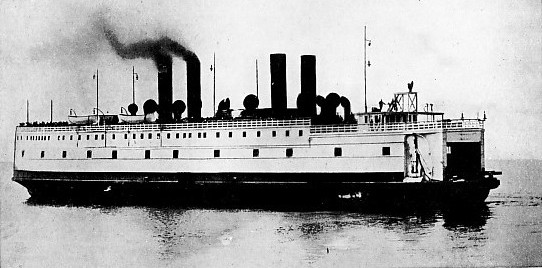

© Shipping Wonders of the World 2024 | Contents | Site Map | Contact Us | Cookie Policy

The “Lake Baikal”
This ship plies across Lake Baikal in connection with the Trans-

THE FERRY STEAMER LAKE BAIKAL
It plies across Lake Baikal, in connection with the trans-
WHEN the Russian Transcontinental Railway was driven across the steppes of Siberia, the advance of the engineers was disputed by Lake Baikal. The first proposal was to swing around the southern end of the lake, but the country was so forbiddingly mountainous, and the work of the engineers was certain to be so slow and tedious, that, in order to secure through railway communication with the East, it was decided to establish a floating railway section upon this inland sea. This was a somewhat startling proposal, seeing that the lake during the winter is completely and thickly frozen over, the low prevailing temperature keeping it firmly locked in this condition for about half the year. Thus it seemed at first sight as if the ferry service would have to be restricted to the summer months only, unless an icebreaker were provided as well, so as to plough the channel for the ferry. Thereupon a combination of the two types of vessels was evolved.
The contract for this ice-
One of the most interesting features in connection with this craft was the fact that she had to be sent in pieces from the Tyne to the distant inland sea. To divide and pack up a vessel weighing 4,200 tons in this manner was no light task. The dismembered ferry was shipped in a steamer to St. Petersburg, where the load was transferred to railway trains and dispatched to the railhead in Siberia, which at the time was some distance from the lake shore. There the packages were transferred to sledges and hauled by horses over the snow-
The ferry has given complete satisfaction, and has demonstrated her capacity to cope with the thickest and heaviest ice peculiar to this lake. The cars being run on at the stern and made fast, and the signal given to go ahead, the vessel steams slowly out of her dock. The nose of the vessel, owing to its peculiar shape, does not cut into the ice, but lifts as with a glancing blow, until it rests upon the surface. Simultaneously, the front screw in its revolutions displaces the water beneath the ice, so that the full weight and force of the hull press down heavily. The ice has to give way, being broken into huge masses, which are flung hither and thither in the open channel behind by the ferry’s wash. Although the railway since has been completed around the end of the lake, giving continuous railway communication, the floating section is still in operation, as the trip across the lake saves considerable time, and is accordingly used for the through fast mail traffic. The Lake Baikal has been in constant use since 1897, and even after some fifteen years’ battling with the winter and ice on this inland sea is as efficient as ever. It is a moot point, in view of the Lake Baikal's achievements, whether the ferry ever will disappear from the trans-
Another novel and large ferry steamer was built in 1895 by the creators of the Lake Baikal for service upon the River Volga, where some very arduous work has to be fulfilled. Not only is the current very swift, but the river rises and falls to a remarkable degree according to the season, the difference in level between winter and summer being no less than 45 feet. Under these conditions, a somewhat novel idea had to be incorporated.
The steamer is 252 feet long, by 55½ feet wide. On her decks four tracks are laid -
The railway ferry undoubtedly constitutes one of the most interesting features of railway operation. Seeing that the system is so successful in all parts of the world, the question may well be asked why it has not been adopted for the maintenance of through railway communication between England and France? In every instance where the idea has been introduced a wonderful increase in the volume of traffic has resulted, so that the floating railway possesses a far-
You can read more on “The Dover-
You can read more on “Train Ferries” in Railway Wonders of the World